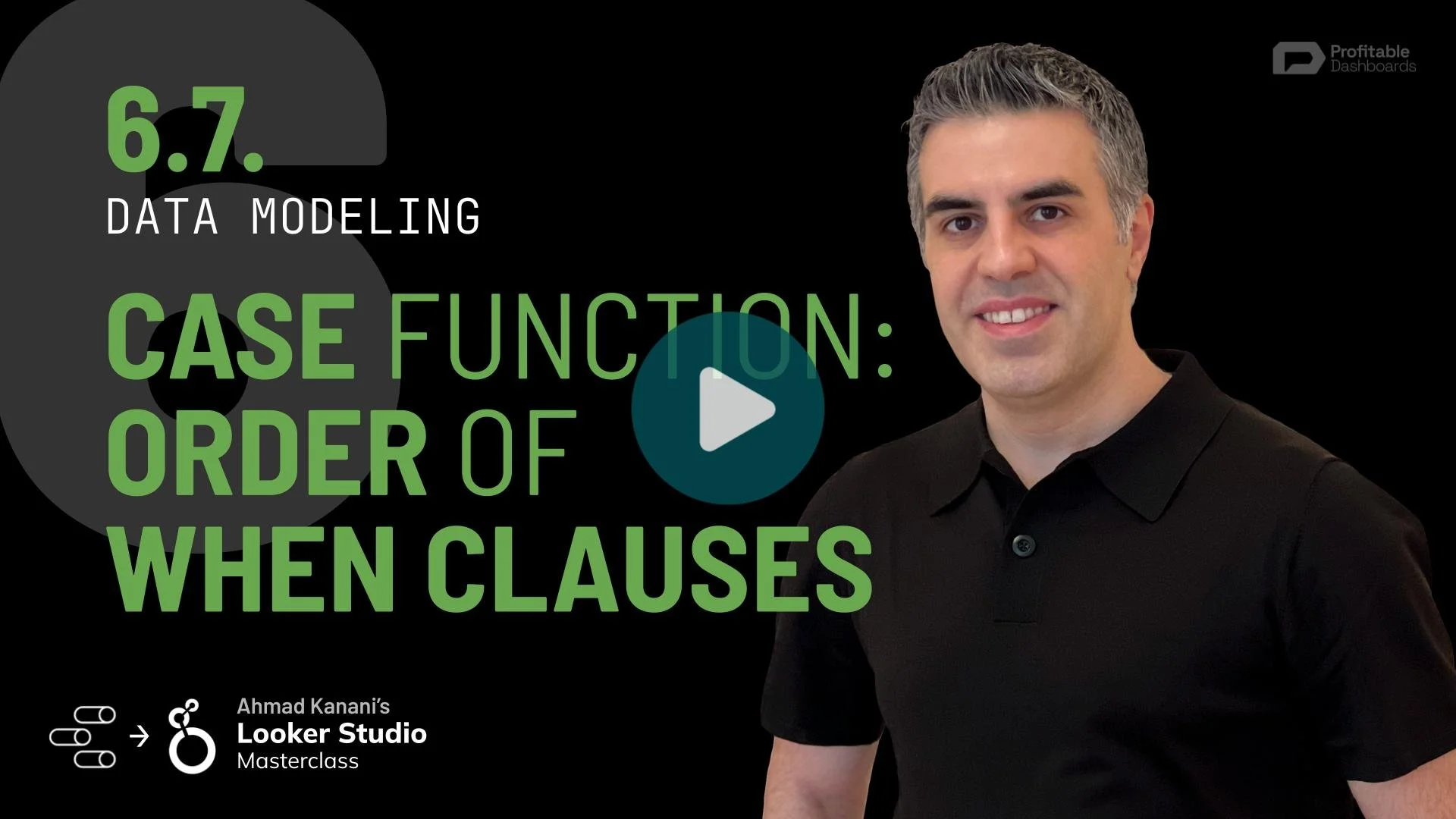6.8. Returning Expressions in Looker Studio CASE Functions
Learn to apply CASE(), CONTAINS_TEXT(), and REGEXP_EXTRACT() functions in Looker Studio for dynamic data expressions and enhanced reporting capabilities
6.7. Order of WHEN Clauses in CASE Function in Looker Studio
Enhance your Looker Studio skills by mastering the CASE function. Learn to fix data categorization issues by properly ordering WHEN clauses for better results
6.6. Cleaning Data with CASE Function
Explore the power of the CASE function in Looker Studio to rectify inconsistent data. Transform your source medium values for clearer insights and reporting
6.5. Tips for Editing Formulas in Looker Studio
Enhance your Looker Studio experience by learning how to format formulas effectively, manage space wisely, and add comments for clarity and collaboration
6.4. CASE Functions with Multiple WHEN Clauses
Learn to implement the CASE function with multiple WHEN clauses to categorize countries into continents, enhancing your data reporting capabilities
6.3. Grouping 404 Pages with CASE Function
Learn to use the CASE() function to pinpoint 404 error pages. This guide provides clear examples to help you categorize web pages accurately and effectively
6.2. The CASE Function in Looker Studio
Master the CASE function to categorize data seamlessly. Explore how to identify serviceable regions for your business and enhance your data analysis skills.
6.1. Grouping Data with IF() in Looker Studio
Learn to utilize the CASE() and IF() functions for data grouping and categorization, transforming your reports with clear, insightful visualizations
5.11. Additional Resources
Enhance your text processing skills with our comprehensive guide to Looker Studio functions and Google RE2 Regex. Explore the best RegEx testing sites
5.10. Every Chart is a Table
Explore the concept of visualizing charts as tables in Looker Studio. This lesson covers scorecards, time series, and bar charts for improved data accuracy.
5.9. REGEXP_MATCH() in Looker Studio
Discover how REGEXP_MATCH() functions in Looker Studio, returning true or false based on string matches with regular expressions. Learn to create content grouping effectively
5.8. REGEXP_EXTRACT() in Looker Studio
Learn to leverage the REGEXP_EXTRACT() function for effective string manipulation and reporting of unique categories in your dataset
5.7. Text Functions: REPLACE() and REGEXP_REPLACE()
Unlock the potential of Looker Studio's REPLACE() function for text replacement. Dive into RegEx functions for efficient text extraction and manipulation in our comprehensive guide.
5.6. Text Functions: LEFT_TEXT() and RIGHT_TEXT()
Learn to utilize LEFT_TEXT() & RIGHT_TEXT() functions for precise text extraction in your data sets, streamlining campaign grouping and dimension categorization
5.5. Text Functions: CONTAINS_TEXT(), STARTS_WITH(), and ENDS_WITH()
Learn about the CONTAINS_TEXT() function and its role in data aggregation, providing Boolean results to streamline category management and prevent fragmentation
5.4. Text Functions: LENGTH()
Discover how to use the LENGTH() function in Looker Studio to count characters in text strings and convert dimension fields to metrics effectively
5.3. Text Functions: LOWER() & UPPER()
Learn to utilize LOWER() and UPPER() functions for managing mixed-case dimension values, enhancing data normalization and improving case-sensitive operations
5.2. Text Functions in Looker Studio: CONCAT()
Discover how the CONCAT() function allows you to concatenate or truncate multiple fields, creating custom dimensions in text format, especially for URL fields
5.1. Cleaning & Normalizing Data with Text Functions
Unlock the power of text normalization in Looker Studio. Our guide covers vital functions such as CONTAINS_TEXT() and LEFT_TEXT() to improve your data visualizations
4.7. Scope of Custom Fields: Chart vs Data Source
Explore the benefits of using chart level versus data source level calculated fields. Centralize your custom fields to enhance your data ownership strategy.




















